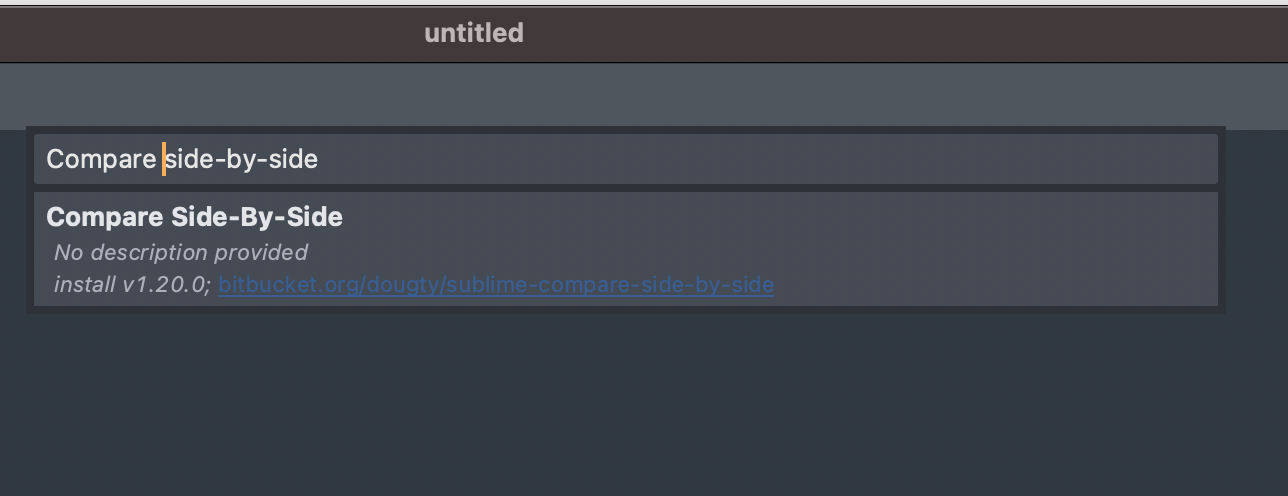
- #Sublime text diff two files generator#
- #Sublime text diff two files update#
- #Sublime text diff two files code#
- #Sublime text diff two files free#
This is not an HTML or CSS tutorial, so I won’t go into the details of the how this works.

layout : default title : " The tools I use to build my website" : /writings/tools-i-use-to-build-my-website/ description : " The tools I use to build my website: GitHub Pages.
#Sublime text diff two files code#
For example, here’s the first few lines of the source code for this article: The content files for Jekyll are normally written in Markdown, and they have a short YAML header which provides metadata like layout, title, and URL.
#Sublime text diff two files generator#
Even a tiny cloud-based virtual machine can serve hundreds of static files per second – easily enough for your site to stay up during a “hug of death”, for example when it’s on the Hacker News homepage.Īs mentioned, GitHub Pages works with the static site generator called Jekyll. The resulting pages can be served by any static file server.
#Sublime text diff two files update#
Static site generation fits that bill very well: whenever you update your site a tool (the “static site generator”) turns your source files into ready-to-serve HTML web pages. I’m a fan of the “small web”: fast web pages with small file sizes than run on comparatively simple technologies.
#Sublime text diff two files free#
GitHub provides free hosting, I say thank you by promoting their product! :-) Static site generation (Jekyll) If you’re not a programmer but are “good with computers” I don’t think you’d have a problem using it – you can use one of the prepackaged themes, and you can use GitHub’s online text editor to avoid having to learn Git. I highly recommend GitHub Pages: it’s free and it just works. Your website’s source repo has to be marked public, but I don’t consider that a problem, because the resulting website is publicly accessible anyway. GitHub Pages allows you to host websites for open source projects, but also allows you to host a personal website tied to your GitHub username. It comes with several prepackaged layouts or “themes”, but you can also use one of the hundreds of free Jekyll themes available online, or make your own. GitHub Pages uses the Jekyll static site generator to produce HTML web pages from your source files, which are usually written in Markdown – more on that below. You can use it with a custom domain name (mine is ), and it even provides free TLS encryption (so https URLs work). You set up a GitHub repository, enable GitHub Pages, and a few minutes later you have a fully working website. I use GitHub Pages, which is GitHub’s free website hosting service. And next time someone asks, I’ll just point them here! Free hosting (GitHub pages) I don’t use a fancy “theme”, just a simple layout I created using a few dozen lines of HTML and CSS.īelow are a few more details if you’re interested. I generally reply with a brief response, saying how I like to keep it simple: I use my text editor to write Markdown files, test locally using the Jekyll static site generator, and then push them live to GitHub Pages using a Git tool.

vimdiff shows the differences between two, three, or four versions of the same file or document.Every so often I get an email from someone starting out in web development who asks something along these lines: “What do you use to create your website, ? Do you use a Content Management System? What theme do you use?” Vimdiff CommandĬompared to diff, vimdiff works in an advanced manner. ND isn’t extended in the kernel part of the operating system.Display word differences between text files.

It works by creating two temporary files, one word per line the use diff command on this files to compare the text. It is very useful if you want to compare two texts for change words.

Wdiff is another wrapper for diff which is used to compare files and documents on a word-to-word basis.


 0 kommentar(er)
0 kommentar(er)
